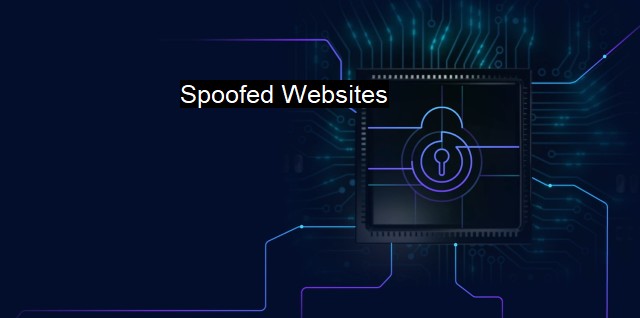What are Spoofed Websites?
The Risks and Ways to Combat Spoofed Websites: Understanding Cyberattacks and How to Protect Against Them
"Spoofed websites" is a term commonly used more specifically in the territory of antivirus protection. This term refers to fraudulent or deceptive websites crafted with malicious intent that closely imitate a particular legitimate website in its design and URL structure. they vastly deviate from the original ones in terms of their dangerous hidden functions. The individuals or groups who create these phishing websites primarily aim to deceive unsuspecting users, tricking them into providing personal or sensitive information or installing malware on their computers.The technique used to create spoofed websites involves convincing duplications of legitimate ones. The creators painstakingly replicate all features in convincing detail. They cleverly mimic the appearance, content, and often even the URL of the official site they are intending to spoof. These layers of deceptive veneer are designed with a singular purpose that belies their benign appearance: to trick the uninformed user into believing they are viewing and interacting with the original website.
A common use of spoofed websites is to coerce visitors into disclosing sensitive personal information. This can mean passwords, credit card numbers, or social security details among others. This information can then be used for all sorts of nefarious purposes from financial fraud to identity theft. In some instances, spoofed websites might urge one to download a piece of software, commonly disguised as an application required to access some feature of the site. This software, often a Trojan horse or other types of insidious malware can provide the attackers unfettered access to one's system.
So, how does one spot a spoofed website? Despite the sophistication of these malicious websites, attentive users can spot subtle differences that give them away. These differences may come in the form of spelling mistakes or other minor visual discrepancies. A critical defense tool is checking the Website's SSL certificate. Legitimate websites have a secure encryption signified by HTTPS in the URL. even this isn't a fool-safe method as some highly-conceived spoofing claims to have SSL certificates.
An important remit of owning any computing system is operating comprehensive antivirus software. Modern antivirus programs usually offer multiple layers of defense against cyber threats, including spoofed websites protection. They often provide safe browsing tools that warn about suspicious websites or known spoofs. these programs are capable of detecting and removing various types of malware. Therefore, using an antivirus that is regularly updated can be a significant guard against these spoofed websites.
Given the increasingly globalised digital environment, international and national regulatory bodies have recognized the need to collaborate and combat the proliferation of spoofed websites. Protocols have been drawn up, cyber laws amended, and best ethical practices shared and implemented. Reactive measures, including take-down procedures for identified spoofed websites, have been harmonized.
Yet the responsibility to fight back against spoofed websites ultimately also lies with each individual user. Users need to remain vigilant and stay informed about the high probability of these nefarious intrusions. Understanding that any application insisting for personal information adherence, any website displaying an overwhelmed focus on form-filling that requires intricate financial tidings, can well be a storm in a tea-cup.
In this era of digital interconnectivity where sensitive information is constantly being transmitted through networks of devices, spoofed websites are perilous threats designed to extract personal data and cause damage. Vigilance, an understanding of the telltale signs of such websites, and sound application of cybersecurity hygiene protocols augmented by reliable antivirus software, is the best safeguard against the threats posed by spoofed websites.

Spoofed Websites FAQs
What are spoofed websites?
Spoofed websites are websites that mimic the appearance of a legitimate website to trick users into entering sensitive information, such as login credentials or credit card information. These websites are designed to look like the real ones, but they are actually created by cybercriminals with the intention of stealing information from unsuspecting users.How can I identify a spoofed website?
There are a few ways to identify a spoofed website. Firstly, check the URL of the website to ensure it matches the legitimate one. Secondly, look for misspellings, grammar mistakes, or poor design, which are common indicators of a spoofed website. Finally, be wary of websites that ask for personal or sensitive information without a valid reason.What are the dangers of visiting spoofed websites?
Visiting spoofed websites can result in a variety of cyber threats, such as identity theft, financial fraud, or malware infections. Cybercriminals can use the information entered into these websites to steal identities or money, or they can infect your device with malware, which can then be used to extract more sensitive information.How can I protect myself from spoofed websites?
To protect yourself from spoofed websites, always be cautious when visiting websites and avoid clicking on suspicious links. Keep your antivirus software updated, and ensure your browser is set to warn you if you are about to visit a potentially dangerous website. Always make sure that the website you are visiting is the real one by checking the URL, and if in doubt, contact the legitimate organization to confirm the website's authenticity.| | A | | | B | | | C | | | D | | | E | | | F | | | G | | | H | | | I | | | J | | | K | | | L | | | M | |
| | N | | | O | | | P | | | Q | | | R | | | S | | | T | | | U | | | V | | | W | | | X | | | Y | | | Z | |
| | 1 | | | 2 | | | 3 | | | 4 | | | 7 | | | 8 | | |||||||